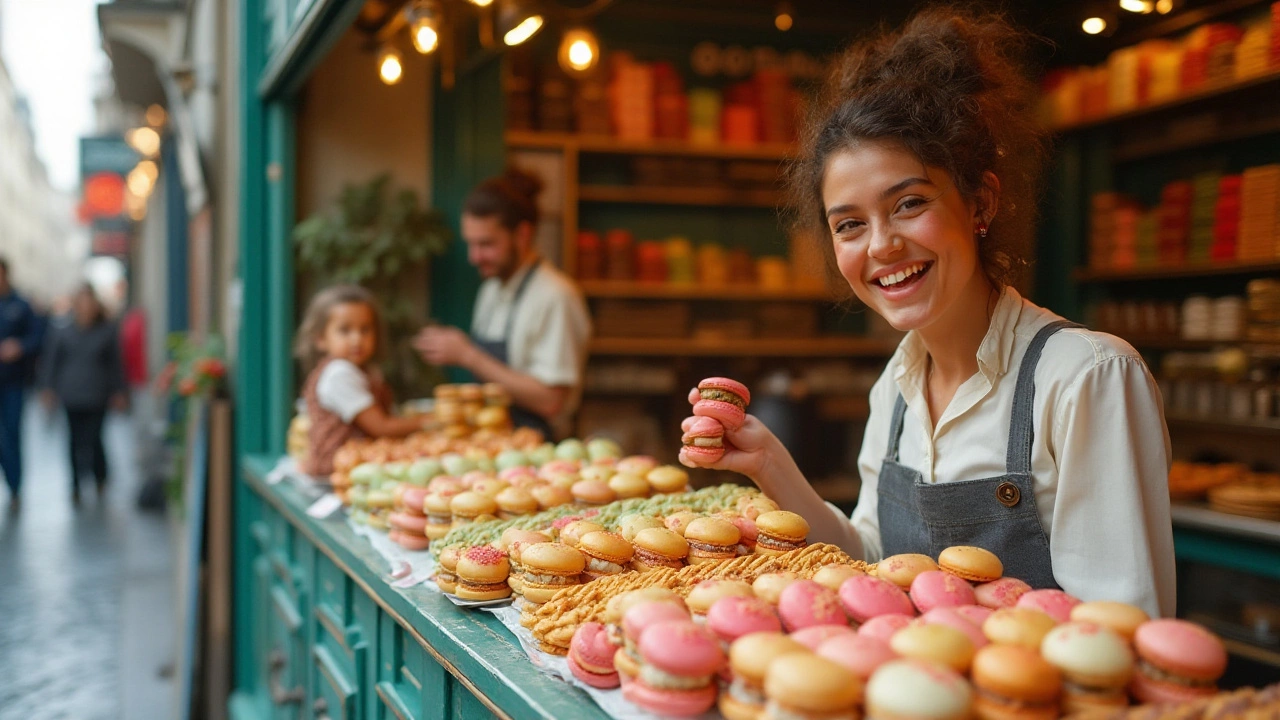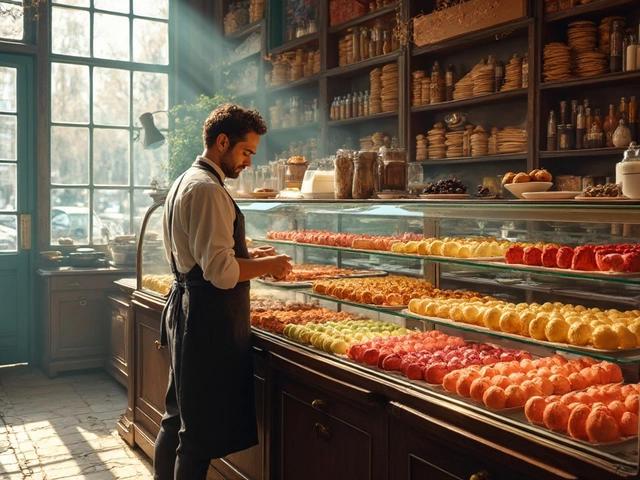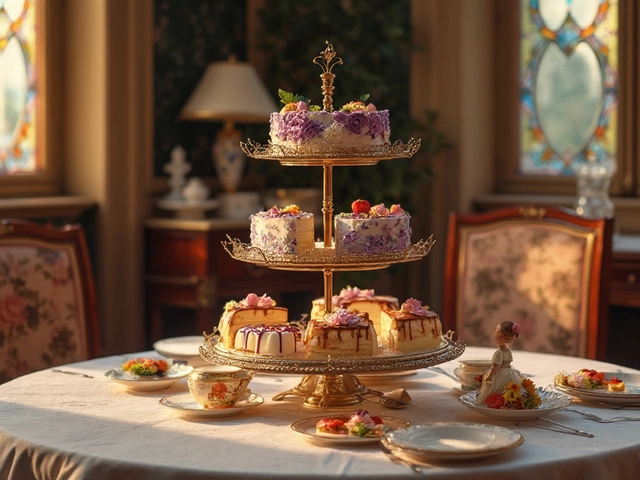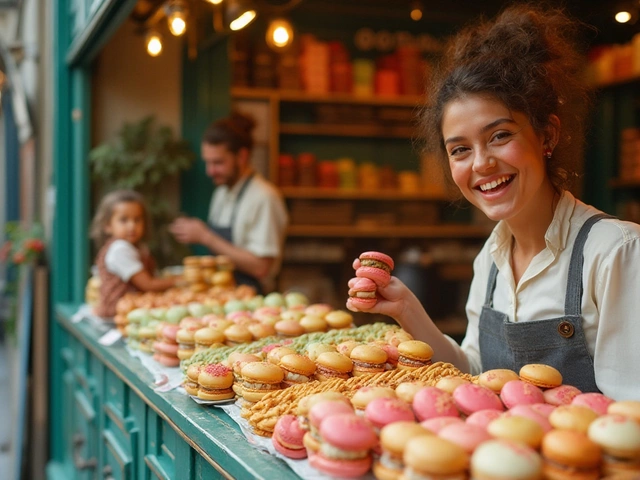Paris, the city of lights, love, and, not to be overlooked, unparalleled culinary treasures—invites you on a sweet adventure. At the heart of this adventure lies the celebrated macaron, a dainty confection that has captured the hearts and palates of many. As versatile and vibrant as Paris itself, these bite-sized delights beckon from patisserie windows, offering an enticing array of colors and flavors.
Much more than a dessert, macarons embody the artistry and history of French patisserie. With delicate shells that give way to a rich center, they promise a taste of bliss that demands careful deliberation in finding the very best. Let us unravel the layers of their story, providing you with the essential guide to navigating through Paris with its divine macarons leading the way. From historic patisseries that have honed their craft over centuries to contemporary kitchens experimenting with daring flavors, the quest to find your perfect macaron is both delectable and deeply rewarding.
- A Brief History of the Macaron
- Where to Find the Iconic Macarons
- Tasting Tips for Choosing Flavors
- Innovative Variations and Unique Finds
- The Art of Macaron Making
- Macarons: A Parisian Souvenir
A Brief History of the Macaron
The macaron may seem like a confection synonymous with Paris, yet its roots stretch far beyond France. This delectable sweet has a story that spans centuries, accented by the charms of different cultures. It isn't just a sweet cookie; it's a culinary bridge that has transcended time. It is said that the macaron, as we know today, originally found its way to France from Italy. Catherine de' Medici, in the 16th century, introduced these almond meringue treats to the French court upon her marriage to King Henry II. The Italians had mastered the art of making these simple cakes, known as maccherone, made only with ground almonds, egg whites, and sugar, which delighted the French nobility of the era.
Interestingly, the true fame of this crisp yet chewy delicacy came much later in France. For more than two hundred years, the macaron was no fancy sandwich cookie. It wasn’t until the early 20th century that the macaron, as we adore today, took its form. Pierre Desfontaines, a celebrated pastry chef from the famous Parisian patisserie, Ladurée, is credited with the innovation of sandwiching two meringue-based cookies with a filling of ganache or jam. This simple yet revolutionary idea transformed the macaron into the colorful, flavorful confection we relish today.
As the years turned into decades, the macaron grew beyond its origins to become a cultural icon in France. It represents the finesse of French culinary art and the nation’s dedication to detail and flavor. It’s curious how something so small can exude such grand elegance. Adding to this allure, modern-day macarons feature an array of flavors unimaginable in the past. It’s true that, aside from traditional tastes like chocolate and raspberry, macaron creators now experiment with the likes of jasmine, matcha, and even exotic flavors like wasabi. Such daring flavor profiles challenge the palate and entice the senses.
Moreover, macarons are often seen as a symbol of celebration. They adorn tables during weddings, afternoon tea settings, and even intimate soirées. The French the pastry’s versatility and aesthetic delight both reflect the deep cultural connection and contemporary craftsmanship that contribute to their worldwide appeal today. John Baxter, a noted expert in Parisian culture, aptly puts it:
"Macarons transcend beyond mere flavor; they are reflections of Paris’s vibrant and ever-evolving culinary scene."This evolving confection continues to surprise and enchant. Whether you are discovering the origins or savoring a newly invented flavor, the macaron remains a testament to its ever-evolving history filled with twists and transformations that reflect its universal fascination.
Where to Find the Iconic Macarons
Wandering through the enchanting streets of Paris is an exploration of culinary excellence, where the delicate macarons hold a revered spot in the city's pastry universe. Yet, not all macarons are created equal, and knowing where to find the crème de la crème is essential for aficionados and newcomers alike. Our journey begins with the historic patisseries that have become giants in the art of macaron-making, some guarding recipes passed down through generations. One can't miss Ladurée, famously recognized not just in Paris but worldwide, for its opulent display and classic macaron flavors like pistachio and vanilla that have been crafted since 1862. Often credited with popularizing the modern double-decker macaron, popping into one of its chic salons feels like stepping into a world of pastel-hued elegance.
Another beacon of French pastries is Pierre Hermé—sometimes referred to as the 'Picasso of Pastries.' Here, innovation meets tradition with a flair for the dramatic, as each delicate treat bursts with imaginative flavors and textures. The Isaphan, a wondrous blend of rose, lychee, and raspberry, stands as a testament to the brand's commitment to pushing boundaries while maintaining an avant-garde yet reliable craft. The delectable goods invite patrons into a multi-sensory experience that connoisseurs say is nothing short of enchanting.
"In Paris, Pierre Hermé's macarons are a must-taste," declares the 'Connoisseur's Guide to Parisian Pastries,' validating its place as a tasting pilgrimage for sweet aficionados.
For those seeking something slightly off the beaten path, Fauchon provides an experience peppered with a bit of unexpected whimsy. Known for its bold use of color and nods to modern art, this iconic store spices up the traditional through seasonal flavors, allowing their myriad of tastes to repeatedly surprise and delight. Stroll into their store and you are met with vibrant selections that seem almost too beautiful to eat. Meanwhile, Dalloyau boasts a pedigree stretching back to the court of Louis XIV, merging regal reminiscence with contemporary taste explorations. Their macarons boast a consistency that manages to feel both familiar and special with every bite.
Yet, the macaron landscape of Paris isn't merely limited to these monolithic houses. Its vibrant charm trickles into the lesser-known corners of the city, where artisanal shops such as Sadaharu Aoki provide exquisite little works of art that blur the lines between Japanese minimalism and French decadence. This innovative fusion attracts many who seek a different texture and taste, offering unique flavors such as matcha and yuzu that enchant the taste buds in unexpected, wonderful ways. As you chart your journey through these storied institutions and hidden gems, the colorful spectrum of Paris's macaron mastery unfolds before you—a sweet-hued testament to the city’s unending creativity and culinary brilliance.
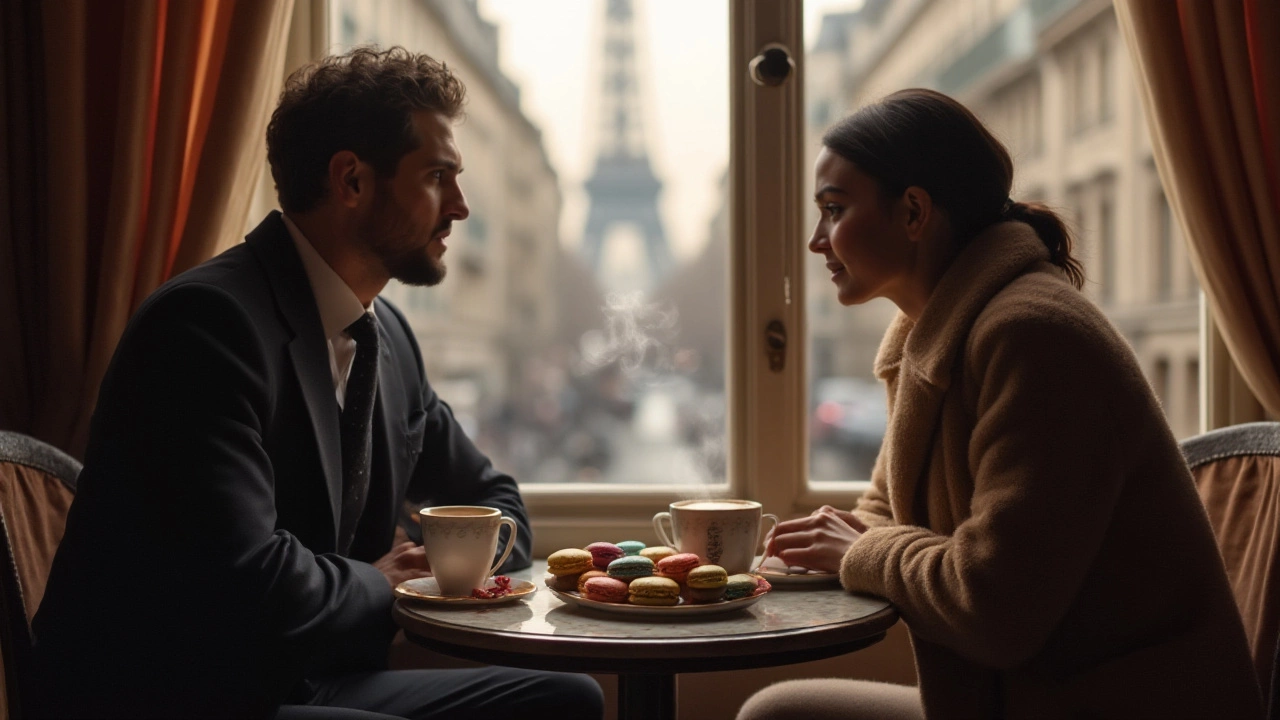
Tasting Tips for Choosing Flavors
Embarking on the journey to discover the best macarons in Paris is both a delightful quest and a multisensory adventure. When faced with a dazzling display of these colorful confections, it's easy to become overwhelmed by the myriad options. However, choosing the right flavors can transform a simple indulgence into a memorable experience. First and foremost, consider starting with classic flavors. The likes of vanilla, chocolate, and pistachio serve as a testament to the pastry chef's skill and provide a baseline for authenticity and quality. These flavors, timeless and revered, often offer a subtle yet complex tasting experience.
As you savor each macaron, pay attention to the texture. A proper shell should be delicate, yielding a light crunch before revealing the softness within. The filling should be a burst of flavor, not too sweet, and balance the almond-rich shell perfectly. If an option presents itself, a quintessential taste test involves a flavor duo, where two complementary choices are tasted in succession—such as coffee followed by lemon, to allow contrast to highlight nuances.
For those seeking adventure beyond the classics, modern patisseries offer a playground of innovative flavors. Look for unique combinations, like matcha and cherry, or indulgent variants such as salted caramel. These choices often reflect seasonal ingredients or regional influences, providing a new perspective on tradition. A visit to Pierre Hermé, a renowned name in the world of macaron artistry, unveils flavors crafted with sophistication and creativity. As the chef himself once said, "In the endless search for taste, each bite reaches perfection...or near it."
Be mindful of the balance between visual appeal and flavor integrity. While vibrant colors can be enticing, they should never overshadow the quality of the macaron itself. Observe the subtle hues of naturally derived colors, which often indicate flavors that favor a purist approach. Pair selections with a good French tea or a dry champagne, as these drinks complement without overpowering the gentle flavors of macarons. Whether you're an aficionado or simply exploring, these tips ensure each experience with these delicate Parisian delicacies leaves a lasting impression on the senses and the soul.
Innovative Variations and Unique Finds
In the bustling and eternally creative city of Paris, traditional culinary favorites like the macaron are continuously being reimagined by avant-garde patissiers. These visionary chefs are not merely tweaking flavors but are leading a revolution in texture, form, and presentation, thereby making these once conventional sweets the epitome of innovation. At the heart of the city, you’ll encounter macarons that defy expectations, blending unconventional flavors that reflect the modern culinary landscape. Not just relegated to sweet profiles, macarons are now venturing into savory territory. Imagine tasting a macaron infused with wasabi or an inventive truffle macaron that entertains your taste buds with a play of flavors you would ordinarily associate with main courses. This bold twist proves that in the realm of French pastries, the sky's the limit.
Amongst the patisseries experimenting with new variations, you might find offerings that lean into seasonal ingredients or collaborate with celebrated chefs across the globe. The result is an exhilarating fusion of traditional French pastry techniques with international influences. The experimentation doesn’t stop at taste—some patisseries are pushing boundaries by reshaping the macaron itself, crafting them into intricate constructions that resemble other classic desserts like tiramisu or key lime pie, further emphasizing their versatility. Such transformations ensure these Paris delicacies remain at the forefront of the culinary world. A stop at Pierre Hermé, for instance, presents a wonderland of such experimental creations, idyllic for the culinary adventurer. Known for their game-changing flavor combinations, Pierre Hermé's creations like the rose and lychee flavored ‘Ispahan’ have become iconic.
The Guardian once described Pierre Hermé’s macarons as "tiny Marie Antoinette-worthy jewels," highlighting their role in transforming traditional expectations.
Beyond these flavor ventures, some Parisian spots craft macarons that tell stories of Paris through their ingredients, crafting experiences rather than merely offerings. Historic flavors reflect the age-old aromas and tastes of classic French cuisine, while cutting-edge creations explore the prospects of culinary art. Macarons with an infusion of elderflower champagne or those that capture the classic taste of a well-loved Parisian bonbon showcase the full spectrum of what can be achieved with patience and imagination. As you sample these diverse offerings, it's also worth noting the beautiful packaging which many patisseries utilize, serving as perfect sends-off for tourists. They often incorporate iconic Parisian elements in their packaging designs, turning each box into a souvenir in its own right, ideal for remembering the tasting journey long after it's over.
With such a vast array of French pastries morphing constantly, it can be helpful to use a flavor guide or ask locals about the latest trending macaron flavors. Many of these unique finds are also deeply informed by seasonal changes, with various shops crafting limited-time offerings that capture the spirit of the moment. Patrons might discover macarons filled with citrus in winter to reflect the sparse brightness those fruits bring to colder months or vegetal notes that herald the freshness of spring. These, cumulatively, invite enthusiasts into the ever-evolving world of macarons beyond the simple almond hues and chocolate tones, painting a vibrant tapestry that celebrates the diverse palates and cultural ethos of contemporary Paris.
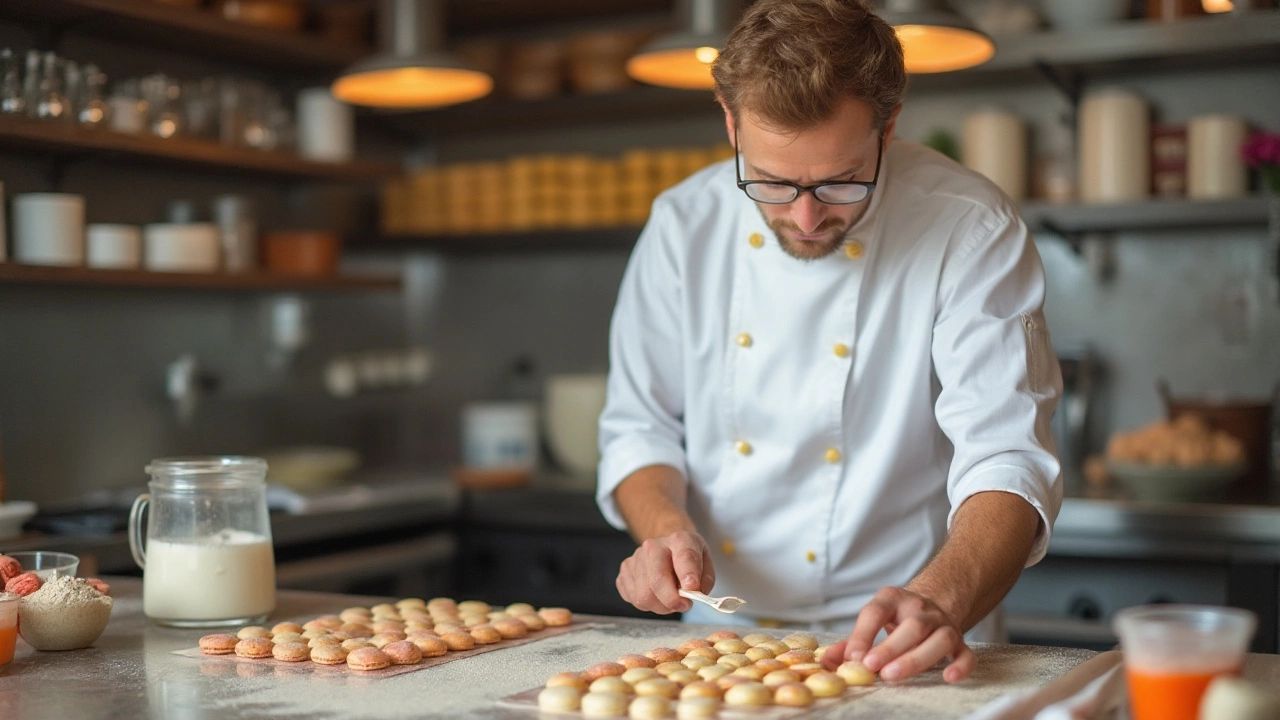
The Art of Macaron Making
The magic behind the perfect macaron lies in its meticulous creation—a balance of precision, patience, and passion. To begin this confectionery journey, one must understand the essential components: almond flour, egg whites, and sugar. These simple ingredients, when masterfully combined, transform into a treat that is both delicate and decadent. The process begins with the almond flour, which must be as fine as powder to achieve that smooth, flawless shell. It's a task that requires sifting several times to remove any imperfections, leaving only the purest form of almond essence behind.
Next, comes one of the most crucial steps: beating the egg whites into stiff peaks before gently folding them with the almond mixture. This step, known as macaronage, requires a gentle touch to ensure the batter flows like molten lava—a consistency that teeters between too thick and too runny. The hypersensitivity of this process is why many bakers equate macaron making to a dance of rhythm and timing. Place the piped disks to set on parchment-lined sheets, and then let them rest. This rest period allows for the formation of a skin, ensuring the signature feet develop during baking. “Achieving the perfect balance takes practice, but it is, in essence, like a culinary ballet,” said Pierre Hermé, a master patissier known for his French pastries.
Once in the oven, the dance continues as the shells rise, forming those ruffled feet distinctive to the macaron’s appearance. The filling, too, adds another layer of complexity. It must complement the shell’s sweetness, offering a juxtaposition in flavor and texture. Classic fillings like chocolate ganache or fruit jams remain popular, yet modern twists see infusions of exotic teas, fragrant herbs, and even adventurous savory fillings. Let us not forget the role temperature plays—a finicky partner in the art of macaron making. Both the meringue and the baking process are sensitive to the changing climate, making attention to detail crucial. A degree too high or low can spell disaster, resulting in cracked shells or hollow interiors.
For those embarking on creating their own poetic treats, consider starting with small batches to practice and perfect your rhythm. With creativity and daring in flavor experimentation, the possibilities are endless, ensuring each batch is as unique as the baker. Some statistics suggest that it might take 100 macarons before you understand the intricacies needed for mastery. But, as many French patisseries will attest, the journey is as satisfying as the final product.
Macarons: A Parisian Souvenir
When it comes to capturing the essence of Paris in a single bite-sized delight, nothing rivals the elegant and colorful macarons. These delicate confections have become a quintessential Parisian souvenir, not just for their exquisite taste, but also for their ability to convey a little piece of France wherever they are taken. As symbols of French art de vivre, macarons have a history as rich as their fillings, tracing back to the Renaissance when they were first introduced to France by Catherine de' Medici. Today, they are as much a part of Paris as the Eiffel Tower or the shimmering River Seine. Tucked into elegantly designed boxes, these sweet treats travel well, making them perfect for sharing the magic of Paris with loved ones back home.
Despite their reputation for luxury, finding the perfect macarons to bring as a souvenir doesn't have to be a daunting task. Paris is dotted with patisseries, each offering their spin on these classic delights. Whether you choose the timeless flavors from Ladurée, a patisserie that's often credited with pioneering the modern double-decker macaron, or opt for the whimsical creative offerings at Pierre Hermé, every box of macarons tells a story. The patisseries' dedication to quality ingredients and traditional methods ensures that every bite is a taste of authenticity and passion, reflective of Paris itself. Bringing home a box of these delights means sharing more than just a dessert; it offers a glimpse into the meticulous art of French patisserie, and a taste of unwritten French romance.
Macarons also make for a thoughtful and appreciated gift thanks to their aesthetic allure and the intricate packaging that often accompanies them. Many patisseries offer customization options—be it engravings on the box or picking exotic flavors that cater to personal tastes. Some travelers find joy in curating their own selection across multiple patisseries, creating a diverse medley of flavors that reflect their individualized journey through the city's culinary landscape. Whether the recipient is a seasoned connoisseur or simply someone with a sweet tooth, a selection of Parisian macarons can delight and surprise, providing a sensory journey through the soft, crispy, and chewy textures combined with vibrant flavors that range from traditional chocolate to surprising rose or even spicy Sichuan pepper.
For those wishing to delve deeper into this culinary tradition before transforming it into a souvenir, many renowned patisseries offer macaron-making classes. Such experiences not only provide the chance to try crafting these delicacies from scratch but also share stories and techniques passed down through generations of French chefs. By understanding the delicate balance of ingredients and the precision required, visitors gain a greater appreciation for the storied macaron. As a result, the macarons you bring back from Paris are more than just a sugary treat—they stand as souvenirs of an experience, memories locked in the hues of pastel shades and the echo of bustling Parisian streets that accompany every bite.
Indeed, as a Parisian souvenir, the macaron fulfills its role as a perfect blend of elegance and joy, much like the city itself. From their flawless structure to the vibrant hues and countless flavor possibilities, macarons encapsulate the fusion of history and innovation. They ingeniously serve the dual role of culinary delight and cultural symbol, connecting the rich heritage of French baking with modern-day creativity. Next time you find yourself in the City of Lights, pack a taste of Paris to savor for later, and let the world see what makes macarons beloved by so many, from everyday Parisians to travelers exploring every corner of the globe.

